-
Posts
2,624 -
Joined
-
Last visited
Content Type
Profiles
Forums
Store
Help Articles
Posts posted by Norm Matthews
-
-
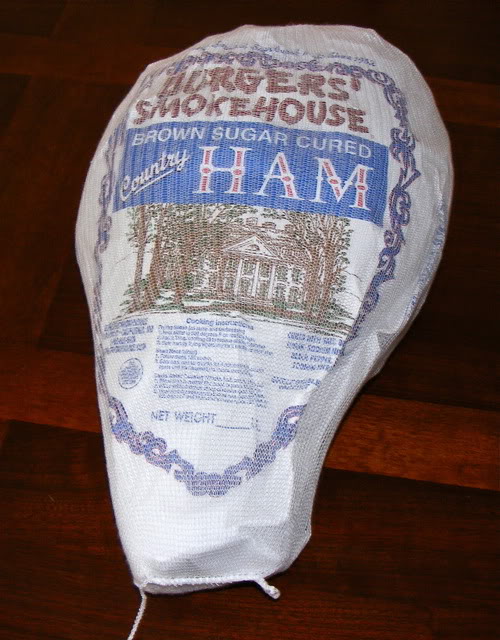
This is the one I usually get. Every year I tell myself that this is the last one, at least for a while but then I get another one every time.
Here is a Heritage Ham source.
http://store.heritagefoodsusa.com/smoked-heritage-ham-bone-in---one-16-lb-roast-p65.aspx
-
Country cured ham, three days in the cooking, let alone who knows how long it took to cure. It is a Missouri cure. Don't ask me exactly what that means, I just know it is hickory smoked and sugar cured.
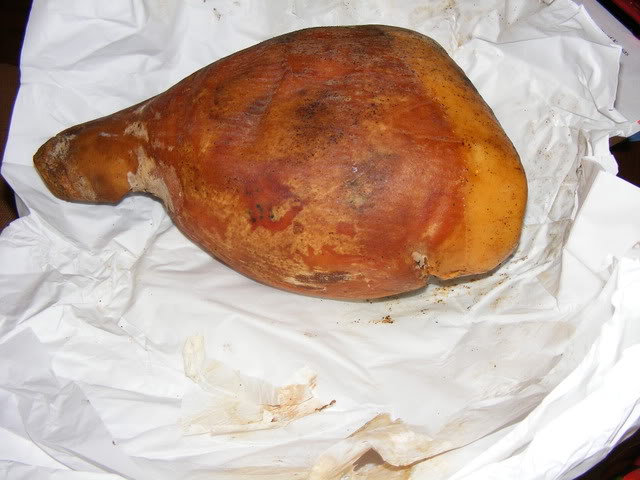
First step is to scrub it with a bristle brush under cold running water
After scrubbed, soak in cool water at room temperature 12 hours- overnight
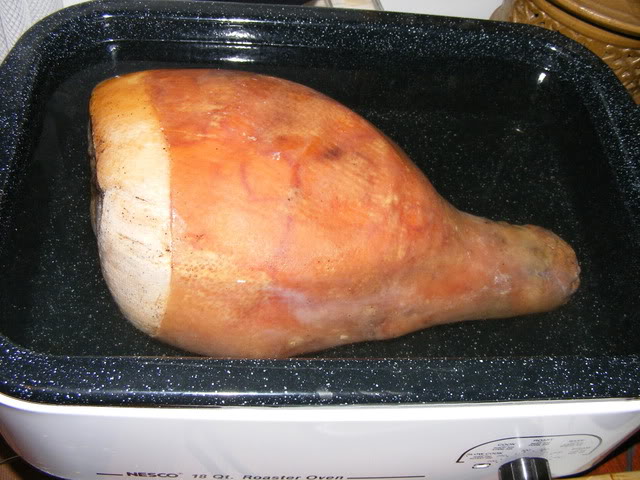
Then change water and simmer 20 minutes per pound (5+ hours) at 250 degrees.
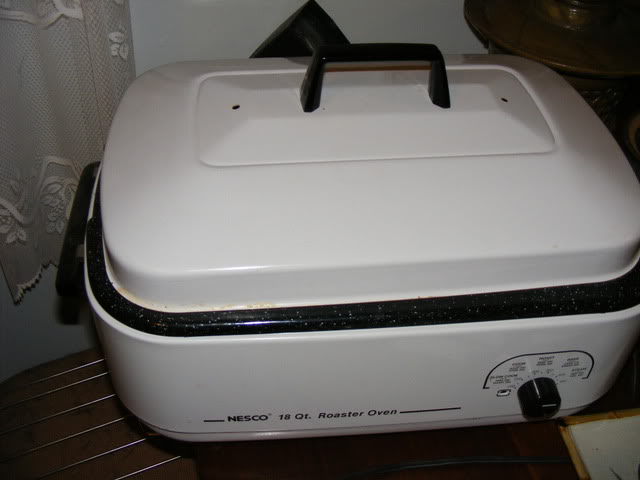
When finished cooking, I covered with a blanket and let cool in cooking liquid- overnight. It was still hot the next morning
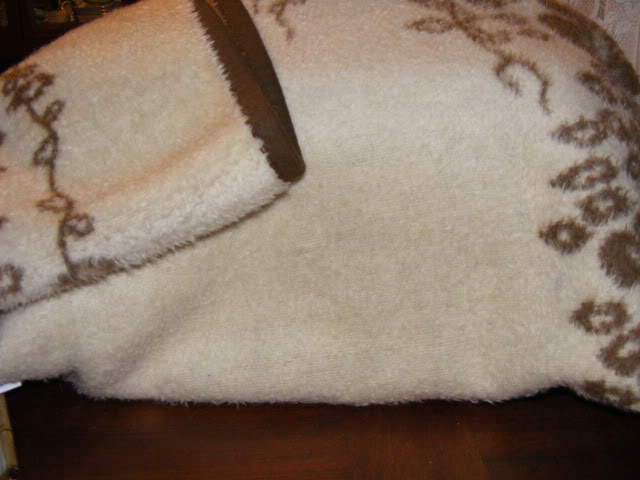
When cool enough to handle this morning, removed from liquid, twisted off end bones, and removed skin and fat. At this point fat could be left on andit could be glazed and baked but it is fully cooked now and it isn't necessary. this one was very lean and had almost no fat so I sliced it into steaks for dinner today. The rest for later.
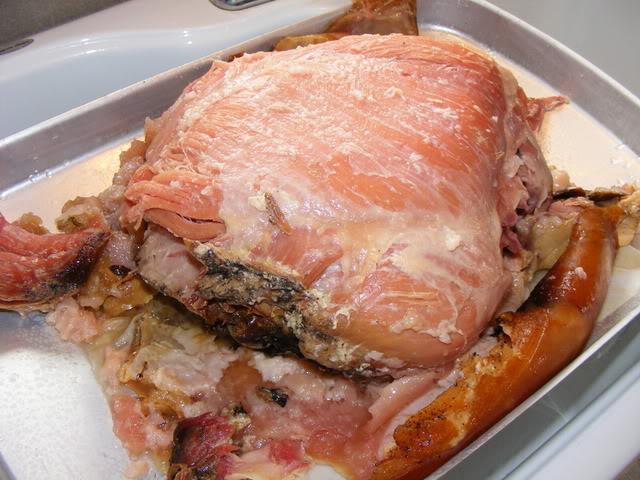
some sliced for dinner, the rest sliced, chopped or what ever for sandwiches, ham salad, the freezer, etc.
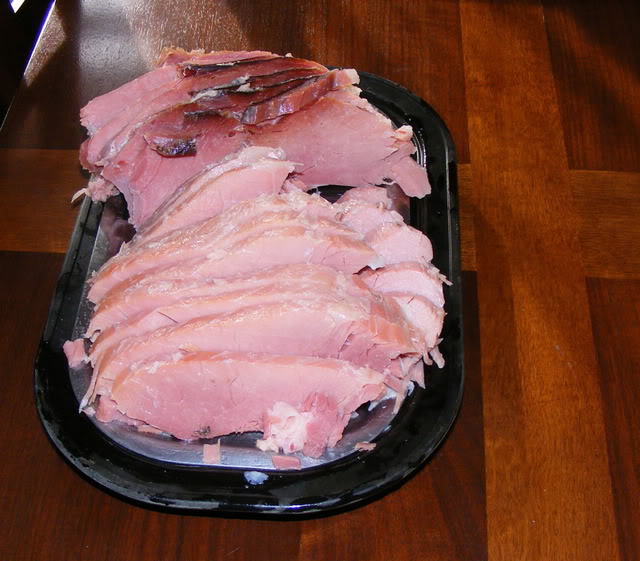
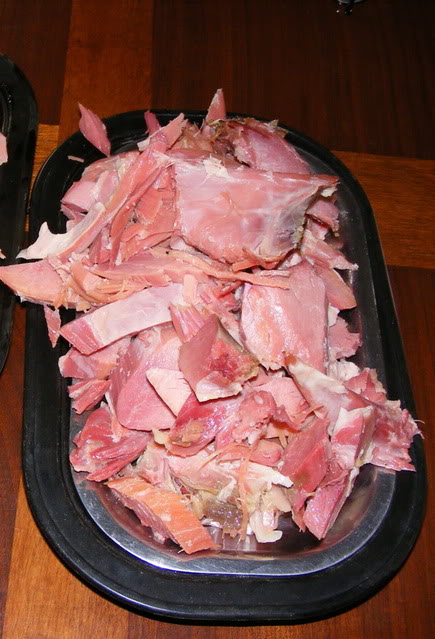
-
Has anyone tried mayacoba beans? I tried some last year and really liked them. The brand I got was Valle Verde. I found this link that tells a little about them.
http://www.ranchogordo.com/mm5/merchant.mvc?Screen=PROD&Store_Code=RG&Product_Code=MAYB01
Doesn't $5.50/pound seem a bit excessive?

They have a much richer flavor than Canellini or great Northern beans . Are they worth the extra money? It is all a matter of perspective I suppose. I notice lots of food items that cost as much as twice the price of similar items and they taste better but not twice as good. All things considered, to me, $5.50 is not a lot of money even though it may be high compared to more common beans.
It's that all their beans are $5.50. Even ordinary beans such as Canellinis, Pintos and Yellow Eyes. Plus $12 for shipping to East coast. I'd sure hope for that much money they're extra special beans. I was at the local coop today and none of the bulk beans were more than $2, except (organic) Canellinis for $2.29. Got some of those and some Black Eye Peas.
Since we're on dry beans, here's an article in the current issue of Maine Organic Farmer & Gardener that's interesting. White Runner Beans – the Northern Gardener’s Lima The author, Will Bonsall, is well known for his work in Maine when it comes to organic gardening.
I got these beans in the Hispanic section at a Walmart grocery. The link I provided was mainly to give information about these beans. You might be able to find a local source or shipper with lower costs.
-
Has anyone tried mayacoba beans? I tried some last year and really liked them. The brand I got was Valle Verde. I found this link that tells a little about them.
http://www.ranchogordo.com/mm5/merchant.mvc?Screen=PROD&Store_Code=RG&Product_Code=MAYB01
Doesn't $5.50/pound seem a bit excessive?

They have a much richer flavor than Canellini or great Northern beans . Are they worth the extra money? It is all a matter of perspective I suppose. I notice lots of food items that cost as much as twice the price of similar items and they taste better but not twice as good. All things considered, to me, $5.50 is not a lot of money even though it may be high compared to more common beans.
-
Has anyone tried mayacoba beans? I tried some last year and really liked them. The brand I got was Valle Verde. I found this link that tells a little about them.
http://www.ranchogordo.com/mm5/merchant.mvc?Screen=PROD&Store_Code=RG&Product_Code=MAYB01
-
No one has attempted to answer this question yet and it has been posted since earlier this morning. I have seen math people put out numbers on things like this but they doing a math exercise and weren't really bakers. I am not a math person by a long shot and I bet as soon as I say what I think, someone will come along and argue with me but just remember I'm giving my limited opinion because no one else has done so yet.
Since the same recipe is going into a relatively similar container- both ceramic glass, both with four corners and the exact same volume, I guess they both will bake at about the same time. The smaller one may take a little longer because the depth is a little greater but really it isn't critical. Just bake until set in the middle.
As for your question about shape, this is a quiche or casserole, not a brownie or cake so it still isn't critical as long as you can tell when it is set in the middle. Cake-like baking in cornered vessels tend to cook at the corners faster because the heat travels in from the sides to the middle of the corner faster than it will travel in from the straight side to the middle while a round container will cook more evenly in to the center... The outside still cooking faster than the center. That is why a cake rises higher in the middle because it has not set and stopped cooking as quickly as the outside diameter.
-
I knew I was going to catch heat for mentioning canned beans but I did so for the purpose of saying that it is a way of tasting a small amount of a variety of bean one had not had in order to get an idea of how it tasted without cooking a batch from scratch.
-
I never measure flour in a bread recipe anymore. It is nice to know how much was used in the recipe but I almost always end up using less. I add the flour to all the other ingredients in the KitchenAid mixer a little at a time until it looks right. In other words just when it stops sticking to the bowl. then I knead in any extra flour or make it softer by kneading it with water on my hands, going by feel and what I know a bread dough should feel like. I have followed recipes that measure by cup and by grams or ounces and it always comes down to what is the best amount for that batch on that day. The brand of flour and type of flour can make a difference too.
I once gave a recipe to a friend from The Grand Central Baking Book. The book is by professional bakers in Seattle and lists the ingredients both by weight and by volume, and he refused to make it. He said it was wrong because his idea of how much a cup of flour should weigh was different from what the book listed. He never measured flour by the cup and the weight the book said was in a cup was different from his preconceived notions. He would not even make it with his idea of what a cup should weigh.
It was not an error in that recipe because the book was consistent in weight/volume of flour throughout the entire cookbook.
-
Except when you are eating BBQ?
 That is one time when they will be on my menu for sure.
That is one time when they will be on my menu for sure. It is pretty hard to explain in words how one bean is different than another. In my opinion, canned beans that have been rinsed and heated taste pretty much like ones cooked from dried. If you taste then from a can, you can tell if you want to cook the dried kind. In order to cook dried beans, most people soak them overnight but it isn't necessary to go to that much planning or to take that much time and trouble. Kidney beans can be cooked directly from dried to finished in a little under a hour and a half in most cases. You probably already know that the older the dried bean, the longer it may take to cook through.
It is pretty hard to explain in words how one bean is different than another. In my opinion, canned beans that have been rinsed and heated taste pretty much like ones cooked from dried. If you taste then from a can, you can tell if you want to cook the dried kind. In order to cook dried beans, most people soak them overnight but it isn't necessary to go to that much planning or to take that much time and trouble. Kidney beans can be cooked directly from dried to finished in a little under a hour and a half in most cases. You probably already know that the older the dried bean, the longer it may take to cook through. -
What kind of meat? Beef? Rib and loin steaks or whole loin or rib roasts or other steaks or rib roasts, loin roasts? Not a good idea with beef rump or chuck roasts. Frankly it does not sound like an idea way to roast anything.
-
kayb,
More than happy to share. Ask any questions you may have and I'll try to help. Here are two recipes. The first one is the one I did this year. The second one is the one I have done twice before but omitted the saffron. I like the second one better but to be fair, the one I made this year was a problem because of the yeast and the thermometer I used, not the recipe itself. The yeast didn't rise rapidly like it was supposed to and the thermometer alarm didn't go off at 190 but 198 instead. Left overs make a very good French toast. I have my own procedures for making bread so I use the ingredients but measure flour by sight and feel instead of by volume or weight. The first recipe seems sweeter, the second one seems eggier. Maybe next time I'll add a little more sugar to the second recipe.
Challah from Chef June
Jewish Egg Bread
makes 2 braided challah (or one large
1 tablespoon dry yeast
1/3 cup water
1/2 cup sugar
6 cups unbleached flour
1 teaspoon sea salt
3 large eggs, lightly beaten
1/2 cup vegetable oil
Approximately 3/4 cup water
1 large egg yolk mixed with 2 tablespoons water (for brushing the loaf)
Poppy seeds (for sprinkling, optional)
1. Dissolve the yeast in 1/3 cup lukewarm water. Add 2 tablespoons of the sugar.
2. In a large mixing bowl, mix flour, salt and sugar. Make a hollow in the center and put yeast mixture in the hole. Mix to a thin paste adding a little flour from the sides. Cover and let sit for about 10 minutes.
3. Add eggs, oil and water to the hole. Combine mixture in hollow with flour around it using a spoon at first, then your hands, and adding additional flour to the bottom and sides as needed. Knead well, about 10 minutes, until dough is smooth.
4. The dough should lose its stickiness and completely clean the bowl. Sprinkle a little flour under dough in bowl. Cover and let rise until double in bulk, about 1 to 1-1/2 hours. Punch down and form into loaves (or one large one).
5. Preheat oven to 375 degrees F. To form into loaves: 1) make one large swirled round by rolling into one long coil, and coiling it upward, with the end sticking out the top; (This is the traditional shape for the New Year.) 2) cut off pieces, knead into balls and put side by side in oiled bread pans; 3) Divide in two. Then divide each loaf into five pieces and roll into long coils. Starting from the middle, braid the coils to each end, and put braid(s) into well-oiled bread pan(s) or onto a large baking sheet well sprinkled with cornmeal. Cover and let rise until almost double in size (about 1 hour).
6. Just before baking, brush tops with beaten egg yolk and sprinkle with poppy seeds. Bake for 35 minutes or until golden brown, and loaf taps hollow. Cool on wire racks.
6 STRAND BRAID: TAKE THE ONE ON THE FAR RIGHT, GO OVER TWO, UNDER ONE AND OVER TWO. REPEAT EACH FAR RIGHT STRAND UNTIL REACHING THE END OF THE LOAF.
CHUCK LOVE
Here's the basic recipe:
Ingredients:
• 2 pkt dry yeast (4 1/2 tsp)
• 5 C bread flour - all purpose will do (unbleached) - You may need more or less
• 1/4 C sugar
• 2 tsp salt
• 1/2 /cup butter (or margarine) room temp
• 1 C hot water (120F) - optional pinch of saffron
• 3 large whole eggs
• 1 egg white
• 1 egg yolk (from the above egg) beaten, mixed with 2 Tbs sugar and 1 tsp cold water
• Optional - poppy seeds
Method:
Prepare a 1/2 sheet pan with a Silpat, parchment paper, or cooking spray.
If using the saffron (to add color to the dough), let it steep in the warm water until the water turns orange (about 10 minutes).
In a stand mixer bowl, combine the yeast, 2 C of flour, sugar, salt and butter (or margarine).
With mixer on medium speed, add the hot water and beat with the flat beater for about 2 minutes, scrape the bowl occasionally.
Add the eggs and the egg white (not the reserved yolk mixed with sugar and water).
The batter will be thick. Beat on high speed for 2 minutes.
Change to the dough hook.
Continue to add flour, adding about 1 C at a time until the dough is no longer sticky.
If the dough is still moist, add a little flour at a time until the dough cleans the sides of the mixer bowl.
Knead by hard or in mixer with dough hook for 10 minutes.
Place dough in a large greased bowl, cover tightly with plastic wrap and let rise until doubled - about 1 hour.
After it has doubled, punch down and hand knead out the bubbles.
Follow the braiding recipe and shape a 6 braid Challah.
Brush the shaped loaf with the egg yolk / sugar glaze. (If using the poppy seed, sprinkle on now).
Allow the loaf the rise, uncovered until doubled - about 1 hour.
While the dough is rising, preheat the oven to 400F
Bake until the loaf is shiny brown, about 40 to 60 minutes.
Test with a toothpick. It should come out clean and dry.
The loaf is fragile, so be careful and place on a cooling rack.
__________________
Chuck Love
-
I love ciopinno. I wish I lived where fresh seafood was available.
-
Thank you Darienne
-
I made some Challah bread today. I used a different recipe that I have in the past. It was a little sweeter. I had trouble with the yeast proofing and used two packets. It was still very slow to rise after making it into a dough but puffed up like on steroids once it went in the oven. I never measure flour anymore. I put all the other ingredients except salt in the KA bowl with the proofed yeast with two cups of flour and beat with a whisk until frothy- about three minutes, then I switch to a dough hook and with the mixer on speed 2, I add the salt and flour until it just barely stops sticking to the bowl and then leave it running for four or five more minutes. Then I knead it by hand until smooth and elastic, as they say, and round it off to make the top stretched, put it in an oiled bowl with some oil sprayed on top to rise. then yada yada yada with the rest of the directions.

-
I suppose you just want to reheat a serving at a time? If so, I'd stick it in the microwave for half a minute.
-
I wanted to do something with cabbage. I thought cabbage rolls but Cass was not enthused so I looked for something and came across bierocks but didn't like any of the recipes I found so made it up as I went. I changed a basic French bread recipe by adding some sugar, oil and an egg and brushing the top with egg and water and sprinkling them with poppy seeds. I tasting the filling as I went. I used cabbage, onion, hamburger salt, pepper, celery seed, Beau Monde, oregano and i don't remember what else. I made 16 and should have added more filling but they were stuffed when I made them and they were good anyway.
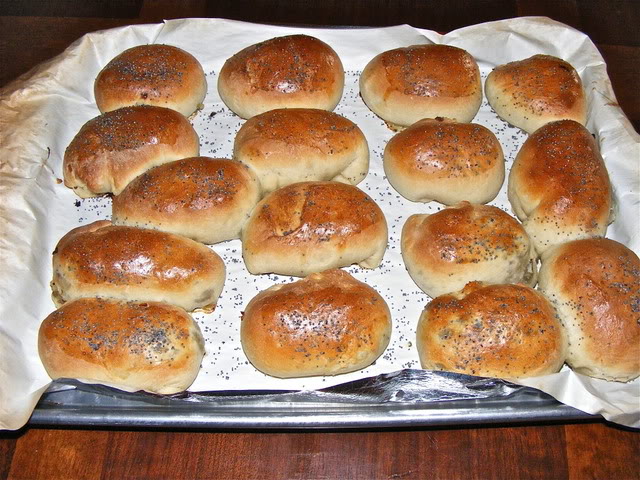

-
Sorry. I didn't know you were talking about such a small ham. I didn't see where you mention a half ham. 5 lbs is smaller that what I was thinking of a fresh ham. They usually run at least 15 lbs and dry cure takes about a week per inch measured to the center.
-
Glad to hear it came out well.
-
One usually thinks of chuck or round for pot roasts. The chuck comes from the shoulder and there are several cuts (and names) for shoulder roasts besides chuck but those -in my opinion- make the best pot roasts. The round also has several cuts. They all come from the other end and are pot roasted but generally don't have as much fat so aren't as taste-y, again in my opinion.
Ground can come from any part of the cow. It may be chuck or round or shank or brisket or flank or a combination of several. What is more important is how lean or fat is it?
-
if your intent is to flavor the pork roast rather than do a true cure to turn it into a real ham, (because a week is not enough time) then have you considered injections?
-
Since the bird does not have skin, you would do well to cover it with a fatty meat. I don't know if pancetta has enough fat to keep the pheasant moist or not. Bacon would and you might consider draping it with cheesecloth soaked in a savory, buttery broth,and atop moist aromatic vegetables, but the one way that you won't have to worry about over-cooking is to do a braise, simmer or fricassee (to use an old fashioned term).
-
Young pheasants that have eaten well will have a layer of fat under the skin and can be cooked in any way that a young chicken can... roasted or broiled. If food for the bird was scarce or it is an older bird, it will best be cooked by moist heat, either braised or simmered.
-
This is a very useful wed site for determining how long refrigerated and frozen foods last.
-
I think a lot of people would be surprised at how many restaurant 'chefs' are actually high school students working part time and don't even know enough to let the fryer heat up after they turn it on before putting stuff in it.



Dinner! 2011
in Cooking
Posted · Edited by Norm Matthews (log)
Oh yum kayb. but I'd need a couple gallons of it for a 15 lb. ham. But the ham is salty. Maybe I can simmer individual slices in apple cider. We get some that was pressed at Louisburg, Ks. that is very good. I have some in the fridge now. Lunch is waiting!